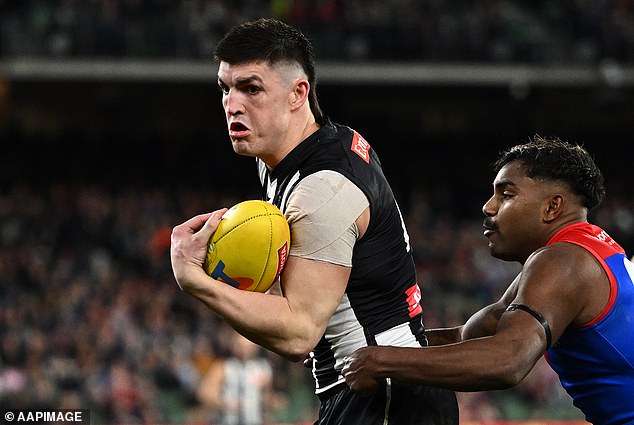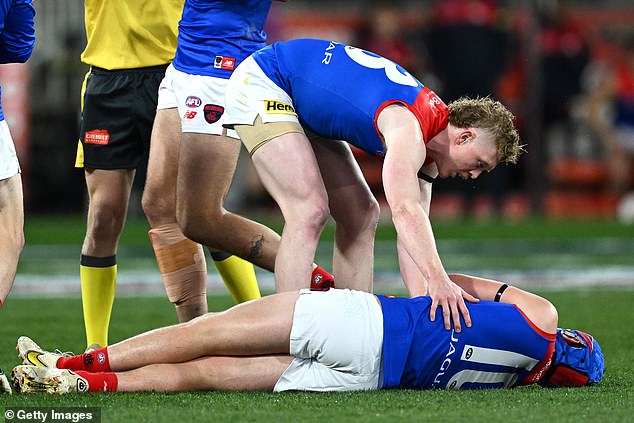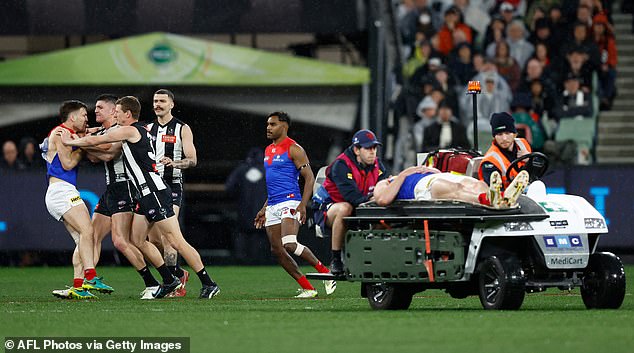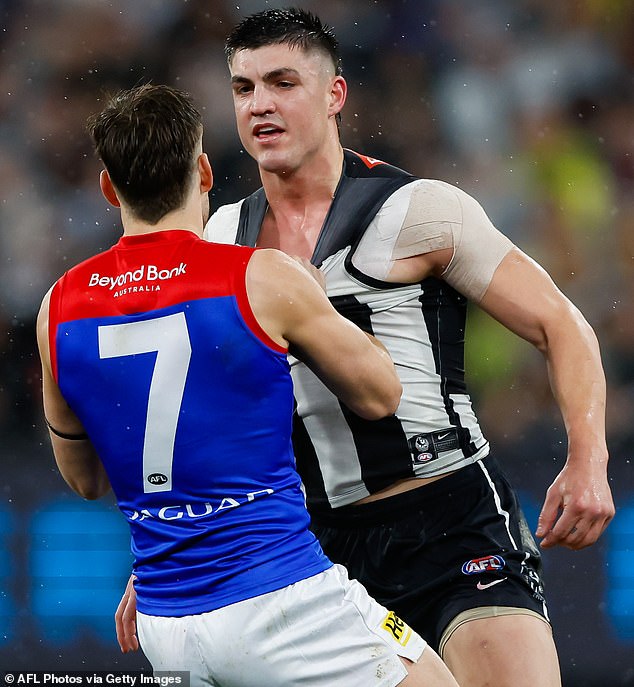AFL coach says bombshell conspiracy theory is the reason the tribunal controversially cleared Brayden Maynard after he knocked out Angus Brayshaw
Former St Kilda coach Grant Thomas has put forward a wild conspiracy theory to explain why the AFL tribunal acquitted Brayden Maynard on Tuesday night.
Collingwood fans feared their enforcer would be banned for the rest of the season after his choke went wrong, which reportedly left Melbourne Demons star Angus Brayshaw out for two minutes.
But after a four-hour hearing, the Tribunal ruled Maynard’s contact was ‘reasonable’, with the defender now free to play in the September 22 preliminary final against Port Adelaide or GWS.
Thomas linked the controversial decision to the AFL wanting to avoid future lawsuits.
‘Common sense prevails. AFL is still considering appealing the decision,’ he posted on X, formerly known as Twitter.
Former St Kilda coach Grant Thomas has put forward a wild conspiracy theory to explain why the AFL tribunal acquitted Brayden Maynard on Tuesday night

Maynard (pictured during the final win over the Demons) faced a lengthy ban after his choke reportedly knocked Angus Brayshaw out for two minutes
‘So they challenged the MRO decision, quashed it and sent it to the tribunal. Now they are considering challenging the tribunal’s decision.
“All for the ‘look’ as evidence against future lawsuits.”
There was also drama before the hearing started, with new AFL chief executive Laura Kane ignoring the findings of the Match Review Officer report from the Magpies-Demons clash.
The move is said to have outraged MRO Michael Christian, who has since threatened to quit after being overruled by Kane.
Christian remains adamant. Maynard had no reason to answer.
Incredibly, the saga may not be over yet: the AFL will decide on Wednesday whether to appeal the ruling, meaning the Pies defender could still be left out of the final.
During the hearing Collingwood called on an expert in biomechanics and neuroscience in an attempt to exonerate Maynard.
Maynard would have been suspended for at least three weeks if found guilty of the abusive conduct charge, which was classified as careless conduct, serious impact and extensive contact.

Angus Brayshaw – who has a history of concussion – faces an uncertain future and will not play in Friday’s semi-final against Carlton

Melbourne Demons players were furious with Maynard, with Jack Viney (pictured left) making his feelings known shortly after the goal
The decision has left the AFL divided as Brayshaw – who has a history of concussion problems – will now miss the Demons’ semi-final against Carlton under the code’s concussion protocols.
Collingwood counsel Ben Ihle said there was only about 120 to 150 milliseconds between the time a Maynard looked in the air at Brayshaw and the time contact was made.
The Magpies called Associate Professor Michael Cole to testify in Maynard’s favour.
Cole, who has an extensive background in biomechanics and neuroscience, believed it was not a conscious decision by Maynard to run into Brayshaw.
In his report, Cole says the average time to make a decision is between 200 and 250 milliseconds, but only in a laboratory-controlled environment where there is a single stimulus and a single response.
In a sports environment where numerous factors must be considered and countless decisions must be made, Cole said the reaction time could be closer to 500 milliseconds.
“I don’t think it was a conscious decision (to bump),” Cole said.
‘My assessment of the footage was that his primary focus was on the ball, his vertical jump was greater than his horizontal jump, but due to his speed and that of his opponent they collided.

During the tribunal hearing, Maynard insisted his sole intention was to smother the ball and was surprised to find Brayshaw had crossed his path.
“Once it flies, it’s essentially a projectile. Like a Frisbee with arms and legs.’
Ihle used color strips on video footage to show how Brayshaw was the one who had ventured into Maynard’s path a bit.
Maynard said his only intention was to smother the ball and he was surprised to find Brayshaw had gone in his direction.
“After I smothered the ball, I looked down and thought, ‘s**t, he’s there,’” Maynard said. ‘It was a surprise that he came my way.
‘You can clearly see that I am walking straight ahead. When I jump to smother the ball, it’s on my right… and then it’s gone to the other side.”
Maynard insisted he never consciously decided to bump into Brayshaw.
“It was almost like a flinch. I got a little stuck,” he said. “And before I knew it, he was on the ground and I was a little upset myself.”
Maynard also dismissed AFL adviser Andrew Woods’ suggestion that he should have either extended his hands to absorb the impact or stretched his arms wide to meet Brayshaw with “open arms”.
